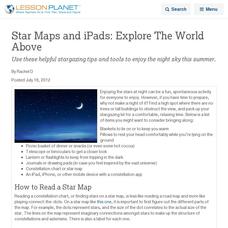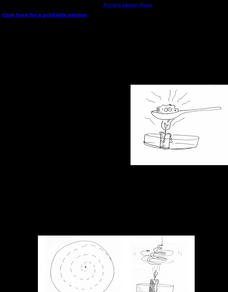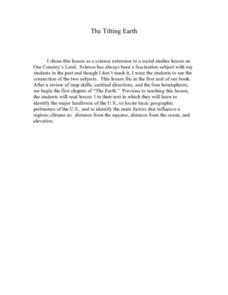Curated OER
Introduction to Animals Concept Map
In this animal science worksheet, students complete a concept map on the features of animals. They fill in 12 blanks with the correct words from the list.
Curated OER
Sponges and Cnidarian Crossword Puzzle
In this marine science worksheet, students complete a crossword puzzle with 32 questions on sponges and cnidarian. They identify the different characteristics of sponges and cnidarian.
Curated OER
How Could You Visualize the Importance of Education
Learners view different pieces of art from artist Candida Alvarez. They discuss what the art means to them. They create their own mobiles showing what they would like out of their education.
Curated OER
Students Speak Up
Students share the ways they use technology at school and at home. In groups, they discuss how their study of math, science and technology is helping to prepare them for future jobs. They share their findings with the class and develop...
Curated OER
Star Maps and iPads: Explore The World Above
Use these helpful stargazing tips and tools to enjoy the night sky this summer.
Curated OER
Creating a Freshwater Ecosystem
Students correctly identify some fishes of Texas and parts of their ecosystem.
Curated OER
Using Ion Exchange Chromatography to Separate Proteins
Students explore protein purification by separating a positively charged molecule, lysozyme, from a negatively charged molecule, albumin, at neutral pH using ion exchange chromatography.
Curated OER
Teeter Totter
Pupils explore the two types of spotted sandpipers. They create a puppet show using the spotted sandpiper from Puerto Rico and the spotted sandpiper from Alaska. Students research the habitats of the two sandpipers.
Curated OER
Cool Lights
Students investigate how and why deep-sea organisms produce light. They examine how these processes can be used to study deep ocean environments.
Curated OER
Introduction to Gas Chromatography
Students analyze gas chromatograms and suggest various applications for gas chromatography.
Curated OER
Twisted Vision
Students explain polarization vision and why some animals have it while others do not. They examine the reasons why it would be helpful for marine organisms to have polarized light.
Curated OER
Where is That Light Coming From?
Students investigate the chemistry of bioluminescence and discuss how various organisms benefit from this trait. They prepare a report about of at least one organism that receives each of the benefits discussed.
Curated OER
Who's for Dinner?
Fifth graders examine life systems within different biomes. They choose paper plates with the names of animals on them. They research the animals, write reports and draw pictures of them. They create a food chain model by arranging the...
Curated OER
The Tilting Earth
Fourth graders use a styrofoam ball on a stick to represent earth and a light bulb in the center of the room to represent the sun. They walk around the light, holding their sticks at an angle to show the tilt of the earth's axis. They...
Curated OER
Microworlds in Waterways Around You Home
Students explore the concept that different waterways support different organisms. After completing experiments, students predict what life-forms exist in each waterway in their area. They research how humans impact the habitat of other...
Curated OER
Separation of Unknowns in a Liquid
Students identify chromatography as method of separating the components of a liquid. Students discover that dyes are composed of more than one component in achieving a particular color in these lessons on paper chromatography.
Curated OER
Robots from Junk
Students create balloon and rubber band models of robotic rovers to investigate the concepts of mass, torque, and friction. Through research and planning, students construct a rover test-bed that simulates the Martian environment.
Curated OER
Technology and Change
Students write a paragraph explaining how a technological innovation from a particular country has affected the world. Using a variety of resources, students identify a technological innovation, giving accurate historical and...
Curated OER
Disease Research Project
Ninth graders explore the human body and how disease affects man. After using the internet and other reference materials to complete research, 9th graders write a paper on the cause and effect of a selected disease. In preparation for...
Curated OER
Skeletal System
Students discuss the need for humans to have a skeletal system and what would happen if we did not have bones. In this skeletal system lesson, students label each bone in the human skeletal system as a group, and then...
Curated OER
Design a Paraplegic Equestrian Saddle
Studnets develop a new equestrian saddle for a paraplegic rider.
Curated OER
"Arsenic and Old Waste": Groundwater Activities Using Modeling
Students develop models of groundwater and pollution flow. They research information using the Internet and develop models of groundwater flow in Stella and Excel.
Curated OER
Getting To Know the Activists Among Us
Students discuss what it means to be an "activist." They identify various types of activist organizations and brainstorm the names of local people and organizations that might fit these categories. They research one of these...

























